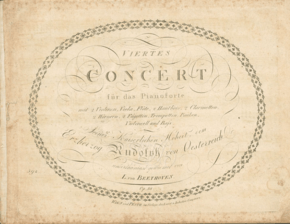Piano Concerto No. 4 (Beethoven)
Ludwig van Beethoven's Piano Concerto No. 4 in G major, Op. 58, was composed in 1805–1806. Beethoven was the soloist in the public premiere as part of the concert on 22 December 1808 at Vienna's Theater an der Wien.
| Piano Concerto in G major | |
|---|---|
| No. 4 | |
| by Ludwig van Beethoven | |
 The composer in 1815, portrayed by J. W. Mähler | |
| Catalogue | Op. 58 |
| Composed | 1805–06 |
| Dedication | Archduke Rudolph |
| Performed | 22 December 1808, Vienna |
| Movements |
|
| Scoring |
|
Orchestration
It is scored for solo piano and an orchestra consisting of a flute, two oboes, two clarinets, two bassoons, two horns, two trumpets, timpani, and strings.
Premiere and reception
It was premiered in March 1807 at a private concert of the home of Prince Franz Joseph von Lobkowitz. The Coriolan Overture and the Fourth Symphony were premiered in that same concert.[1] However, the public premiere was not until a concert on 22 December 1808 at Vienna's Theater an der Wien. Beethoven again took the stage as soloist. The marathon concert saw Beethoven's last appearance as a soloist with orchestra, as well as the premieres of the Choral Fantasy and the Fifth and Sixth symphonies. Beethoven dedicated the concerto to his friend, student, and patron, the Archduke Rudolph.
A review in the May 1809 edition of the Allgemeine musikalische Zeitung states that "[this concerto] is the most admirable, singular, artistic and complex Beethoven concerto ever".[2] However, after its first performance, the piece was neglected until 1836, when it was revived by Felix Mendelssohn. Today, the work is widely performed and recorded, and is considered to be one of the central works of the piano concerto literature.[3][4]
Movements

I. Allegro moderato
The first movement opens with the solo piano,[lower-alpha 1] playing simple chords in the tonic key before coming to rest on a dominant chord. The orchestra then enters with the same theme, in B major, the major mediant key, which is in a chromatic mediant relationship to the tonic. Thus enters the first theme.
The orchestra states the main theme in B major, dropping through the circle of fifths to a cadence in the tonic, G major. The theme is then stated again, this time in stretto between upper and lower voices. A very strong cadence in the tonic, withering away within one bar, introduces a transitional, modulatory theme with restless triplet accompaniment, also containing hints of stretto. The music moves to the minor mediant key, B minor, while its dynamic is reduced to pianissimo, at which point material from the opening theme returns. Through a rising bass line and sequential harmonies, the music regains the tonic key (on a dominant pedal) with a new theme derived from bars 3, 4, and 5. The final cadence is delayed for several bars before the material from the opening bar resurfaces as the movement's closing theme, accompanied by a tonic pedal over forte dominant chords.
Felix Salzer says the following about this opening, "[It is] one of the most fascinating substitutions of the entire literature...The whole passage appears as a most imaginative prolongation of interruption, the post-interruption phrase starting with a B-Major chord boldly substituting for the tonic. In addition, this post-interruption phrase introduces a very interesting melodic parallelism in form of an augmentation of the end of the pre-interruption phrase one step higher."[5]
The piano's entrance resembles an Eingang, an improvisatory passage from Mozart's day that would have occurred after the orchestra's last unresolved dominant chord, but before the piano played the main theme. Beethoven captures this improvisatory style by accelerating the rhythm in the piano part, from eighth notes, to triplets, to sixteenth notes, and finally in a scale that rushes downward in sixteenth-note sextuplets. A long preparation is then made before a tonic cadence duly arrives, and the orchestra once again takes up the main theme.
II. Andante con moto
The second movement has been associated with the imagery of Orpheus taming the Furies (represented, respectively, by the piano and unison strings) at the gates to Hades, a suggestion of Beethoven's 1859 biographer Adolf Bernhard Marx.[6] The movement's quiet E minor ending leads without pause into the C major chords that open the finale.
III. Rondo (Vivace)
In contrast to the preceding movements, the third movement, in traditional rondo form, is simpler, characterized by a very rhythmic theme. The main theme begins in the subdominant key of C major before correcting itself to reach a cadence in the tonic G major.
Cadenzas
Cadenzas for the Fourth Piano Concerto have been written by a number of pianists and composers throughout its history; these include Beethoven himself (two separate sets of cadenzas), Johannes Brahms, Clara Schumann, Ferruccio Busoni, Hans von Bülow, Ignaz Moscheles, Camille Saint-Saëns, Anton Rubinstein, Wilhelm Kempff, Nikolai Medtner, Eugen d'Albert, Leopold Godowsky, Wilhelm Backhaus, Samuil Feinberg, Manuel M. Ponce, etc.
References
Notes
- Another classical concerto which begins with solo piano rather than full orchestra is Mozart's Piano Concerto No. 9 (Jenamy), K. 271.
Citations
- Steinberg, Michael. The Symphony: A Listeners Guide. pp. 19–24. Oxford University Press, 1995.
- Allgemeine musikalische Zeitung, 17 May 1809, p. 523
- Wilson, Conrad (2005). Notes on Beethoven: 20 Crucial Works. Wm. B. Eerdmans Publishing. p. 44. ISBN 0802829309.
- Swafford, Jan (1992). The Vintage Guide to Classical Music. Vintage Books. p. 192. ISBN 0679728058.
- Salzer, Felix, Structural Hearing, p. 195, Dover 1962, ISBN 978-0-486-22275-2
- Jander, Owen (1985). "Beethoven's 'Orpheus in Hades': the Andante con moto of the Fourth Piano Concerto". 19th-Century Music. 8 (3): 195–212. doi:10.2307/746511. JSTOR 746511.
External links

- Piano Concerto No. 4: Scores at the International Music Score Library Project (IMSLP)
- Freed, Richard. Piano Concerto No. 4 in G major, Op. 58, program notes, Kennedy Center. Accessed 6 October 2019.
- Program note by Thomas May, Kennedy Center